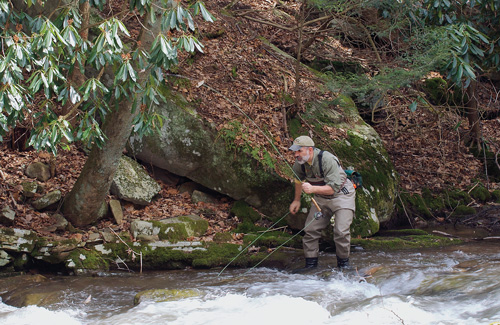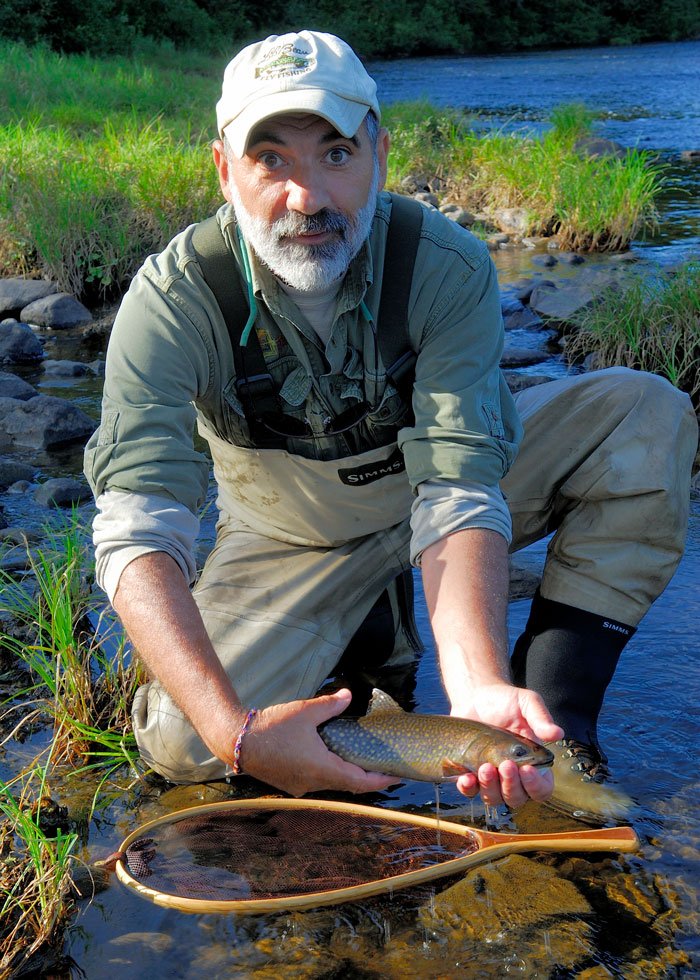
Fishing With Faeries, by Robert J. Romano, is an enticing chronicle of a fly fisher's extraordinary relationship with a magical piece of water. Constructed as a diary recounting a number of days stretched through one season of fishing, Bob Romano explores the charm of a place removed entirely from the ordinary aspects of everyday life; the kind of place you might find faraway in Montana or northern Ontario.
But this is a journal of enchantment waiting in the woods of Northwest New Jersey, along a tiny stream under the "jurisdiction of the National Park Service and the protection of a small clan of wood sprites that reside along its banks." Although he asserts that his work is fiction, many of the places the author describes will be familiar to readers who know and love the Delaware Water Gap National Recreation Area. For Bob Romano his superb skills as a fly fisher, and the more universal knowledge he has acquired during his pursuit of those abilities, have allowed a special appreciation of the little stream and a keen sense of the natural and spiritual world around it.
The narrative opens with the beginning of spring, before the onset of the "official" trout season defined by New Jersey's Department of Fish and Wildlife. Non-stocked waters can be fished all year, and this stream is one of a handful of "piddling creeks designated as wild trout waters to satisfy those kooks who insist on fishing for three-inch brookies." Since the state last stocked it in the 1960s, a population of wild trout has flourished in this trivial run of water. These fish are crafty, vigilant, and not easily fooled. Romano knows every twist and turn along the brook, every tree and rock. The water and woods are as alive as the brookies, the rainbows and the browns, some of which are old friends he calls by name. He quickly catches (and always releases) a 9 inch rainbow with a #16 Black Gnat, "an auspicious beginning to the new season." A few days later he's "playing tag" with big browns and raises the "Old Groaner" for the third time in as many years. On an early June evening there is an encounter with a 20 inch brown.

Pool after pool, fish after fish, each episode is exquisitely told, usually amended with thoughts about the general nature of things. Romano's writing is precise in describing his methods and approaches, yet full of whimsy and romance. These accounts are not intended as an instructional guide; still there is plenty of information woven in for the aspiring fly fisher, and to pay homage to his craft. There is frequent reference to, and reverence for, a large and fascinating volume of literature dating back to A Treatyse of Fysshynge Wyth an Angle written in 1496 by Dame Juliana, a woman, within the stone walls of a nunnery. In 1653 Izaac Walton wrote The Compleat Angler, one of the three most published books in English literature. (The other two are the Bible and the Complete Works of William Shakespeare.)
A quick lesson in elementary entomology describes a trout's diet of mayflies, stoneflies, and caddis and their life stages as nymphs and spinners. Dry flies imitate insects on the surface, wet flies under the surface. Emerger patterns simulate mayflies and caddis struggling to emerge within the surface film of the stream. Romano talks about the guys who created the flies and all the hundreds of combinations made from silk, rabbit hair, fox fur, woodchuck fur, feathers from the ass of a duck. Gold Ribbed Hare's Ear, Royal Wulff or Adams, a Blue Dun, Blue Quill, or Blue-Winged Olive; all are like hues created on a painter's pallet.
A version of the Hendrickson fly was dubbed in the 1940s with the urine stained fur of a female fox to perfectly imitate the pink hue of a particular mayfly. A patch of amadou, a fungus once used by surgeons to blot away blood, comes in handy to dry a fly before recasting. How did people come up with this stuff? And what is it that captivates this fisherman as so many for so long before him? Faeries?

To Bob Romano, fishing this stream is like playing the violin, weaving a tapestry or painting a masterpiece. It is something that demands skill, respect, discipline, patience, and love. And there is something magic about attaining virtuosity in this as in any other art. "I begin to focus on the stream to the exclusion of everything else, in a zone as intense as that of a Zen master. The warmth of the sun on my forearms and the back of my neck, the rhythm of the current passing over my ankles, the song of the warblers flitting between the brambles, the breeze intermittently rustling through the trees, all fade toward the outer edges of my consciousness." He becomes part of the scene, not just an observer, in a world where the empirical reality, upon which his craft is based, fades, and the faeries appear, usually to confound his efforts by snagging his fly or slapping him in the face with a tree branch. It is this spiritual quality that brings this man--an accomplished, successful attorney who could fish anywhere in the world-- back, again and again, to the little stream near his Blairstown home.
This fisherman readily admits his reluctance to share this precious place with other people in the woods, usually disdainfully referred to as "tourists". He, of course, must understand that at least some of those hikers and birdwatchers seek the same kind of wonderful sanctuary he has found. Still he is wary of casual wandering through the glen. "Perhaps the tricks played by the faeries are not necessarily for their amusement or even to impress upon me the skills necessary to fool wild trout, but rather a rite of passage to be endured by all anglers to determine their fealty toward the streams they frequent. Only after suffering through the countless trials and tribulations heaped upon them by the faeries can they appreciate the mystical qualities of those places where wild trout abound."
Above all, Romano wants us to understand how momentary the magic can be. Late in November he returns to a favorite spot to find a large pool drastically altered by a ranger who cut away a log that held the water. He mourns the loss of this place that once held so much wonder.
"I have spent over forty of my forty-eight years tramping around streams and rivers, the last fifteen almost exclusively on the little stream. Wild places have a way of jealously guarding their secrets. During my time in this place, I have tried to listen as carefully as I could to what the stream and its faeries have been willing to teach me. Every now and again, I have been graced with the clarity normally reserved for zealots and revolutionaries, and although fleeting, such insight has revealed to me that man's attempts to control the uncontrollable are fruitless.
"Of all the lessons learned, perhaps the most important is that the essence of this magical place can so easily vanish never to return. The stream's power remains as fragile as the trout that are born, raised, and die within its narrow banks. Although potent, the spell of the little stream is ephemeral. Desecration by man can destroy it in a single season."
Romano's other book, Shadows in the Stream, contains
the author's reflections on lake, pond, river and streams in western
Maine. Soft cover:
$20.00.
For more information check Bob's website or contact
via email.